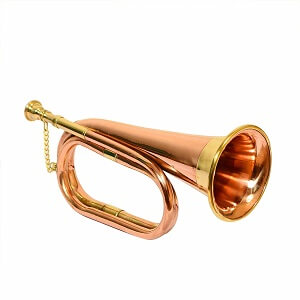Bugle
 Bugle, wind instrument sounded by the vibration of the lips against a cup mouthpiece. As a modern military signaling instrument, it dates from about 1750, when Hanoverian Jäger (light infantry) battalions adopted the semicircular copper horn with widely expanding bore, used by the Flügelmeister, an official of the hunt. English light infantry did the same, the German flügelhorn, or horn, taking the name bugle horn (from Old French bugle, derived from the Latin buculus, “bullock”). This early semicircular bugle was pitched in C or D, often lowered to B by a coiled crook, a detachable piece of tubing. From about 1800 it was once-looped in trumpet shape; the British design, twice-coiled with narrow bell, became official in 1858.
Bugle, wind instrument sounded by the vibration of the lips against a cup mouthpiece. As a modern military signaling instrument, it dates from about 1750, when Hanoverian Jäger (light infantry) battalions adopted the semicircular copper horn with widely expanding bore, used by the Flügelmeister, an official of the hunt. English light infantry did the same, the German flügelhorn, or horn, taking the name bugle horn (from Old French bugle, derived from the Latin buculus, “bullock”). This early semicircular bugle was pitched in C or D, often lowered to B by a coiled crook, a detachable piece of tubing. From about 1800 it was once-looped in trumpet shape; the British design, twice-coiled with narrow bell, became official in 1858.
The popularity of the bugle horn at the end of the 18th century is reflected both in the publication of many bugle marches with military band and in the featuring of the instrument in light operas. In 1810 Joseph Halliday patented the key bugle, or Royal Kent bugle, with six brass keys (five closed, one open-standing) fitted to the once-coiled bugle to give it a complete diatonic (seven-note) scale. It became a leading solo instrument in military bands until replaced by the cornet. In France it inspired the ophicleide, its bass version.
The valved bugle also gave rise to related instruments in the tenor, baritone, and bass ranges. Their names vary from country to country and often apply to more than one instrument. They include the baritone, euphonium, and the saxhorns (some of which are also referred to as flügelhorns). These instruments also vary in the degree to which they retain the bugle’s characteristic wide bore.